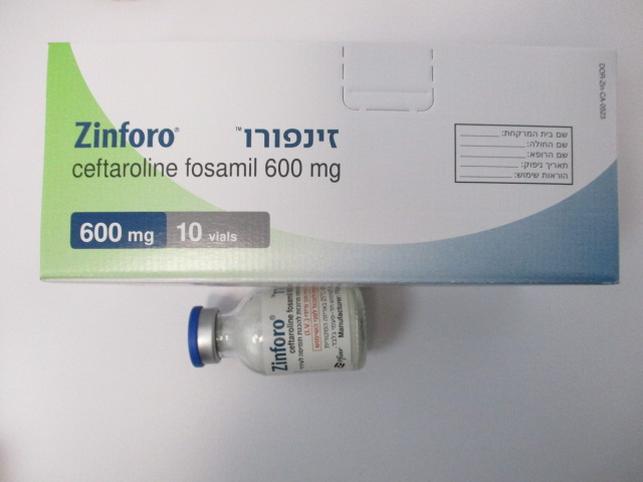Quest for the right Drug

זינפורו ZINFORO (CEFTAROLINE FOSAMIL)
תרופה במרשם
תרופה בסל
נרקוטיקה
ציטוטוקסיקה
צורת מתן:
תוך-ורידי : I.V
צורת מינון:
אבקה להכנת תמיסה מרוכזת לעירוי : POWDER FOR CONCENTRATE FOR SOLUTION FOR INFUSION
עלון לרופא
מינוניםPosology התוויות
Indications תופעות לוואי
Adverse reactions התוויות נגד
Contraindications אינטראקציות
Interactions מינון יתר
Overdose הריון/הנקה
Pregnancy & Lactation אוכלוסיות מיוחדות
Special populations תכונות פרמקולוגיות
Pharmacological properties מידע רוקחי
Pharmaceutical particulars אזהרת שימוש
Special Warning עלון לרופא
Physicians Leaflet
Adverse reactions : תופעות לוואי
4.8 Undesirable effects Summary of the safety profile The most common adverse reactions occurring in ≥ 3% of approximately 3,242 patients treated with Zinforo in clinical studies were diarrhoea, headache, nausea, and pruritus, and were generally mild or moderate in severity. Clostridium difficile-associated disease (CDAD)and severe hypersensitivity reactions may also occur. A greater incidence of rash in Asian patients (see below) and a greater incidence of DAGT seroconversion (see section 4.4) were observed in a study of adult patients with cSSTI conducted with Zinforo 600 mg administered over 120 minutes every 8 hours. Tabulated list of adverse reactions The following adverse reactions have been identified during clinical trials and post-marketing experience with Zinforo. Adverse reactions are classified according to System Organ Class and frequency. Frequency categories are derived according to the following conventions: very common ( ≥ 1/10), common (≥ 1/100 to < 1/10), uncommon (≥ 1/1,000 to < 1/100), rare (≥ 1/10,000 to < 1/1,000), not known (cannot be estimated from the available data). Table 5 Frequency of adverse reactions by system organ class from clinical trials and post-marketing experience System Very Common Uncommon Rare Not known organ class common Infections and Clostridium infestations difficile colitis (see section 4.4) Blood and Anaemia, Agranulocytosis* lymphatic leucopenia, Eosinophilia* * system neutropenia , disorders thrombocytopenia , prothrombin time (PT) prolonged, activated partial thromboplastin time (aPTT) prolonged, international normalized ratio (INR) increased Immune Rash, Anaphylaxis system pruritus hypersensitivity disorders (e.g. urticaria, lip and face swelling) (see sections 4.3 and 4.4) System Very Common Uncommon Rare Not known organ class common Nervous Headache, Encephalopathy*,+ system dizziness disorders Vascular Phlebitis disorders Respiratory, Eosinophilic thoracic and pneumonia* mediastinal disorders Gastrointestin Diarrhoea, al disorders nausea, vomiting, abdominal pain Hepatobiliary Increased disorders transaminase s Renal and Blood creatinine urinary increased disorders General Pyrexia, disorders and infusion site administratio reactions n site (erythema, conditions phlebitis, pain) Investigations Coombs Direct Test Positive (see section 4.4 ) * Adverse Drug Reaction (ADR) identified post-marketing. + Risk of encephalopathy is higher in patients with renal impairment in whom the dose of ceftaroline has not been appropriately reduced (see sections 4.2 and 4.9). Description of selected adverse reactions Severe Cutaneous Adverse Reactions SCARs (Stevens-Johnson syndrome, toxic epidermal necrolysis, drug reaction with eosinophilia and systemic symptoms, acute generalised exanthematous pustulosis) have been reported with beta-lactam antibiotics, including cephalosporins (see section 4.4). Kounis Syndrome Acute coronary syndrome associated with an allergic reaction (Kounis syndrome) has been reported with other beta-lactam antibiotics. Rash Rash was observed at a common frequency in both the pooled Phase III studies in cSSTI with administration of Zinforo every 12 hours (600 mg administered over 60 minutes every 12 hours) and the study in cSSTI with administration every 8 hours (600 mg administered over 120 minutes every 8 hours). However, the frequency of rash in the subgroup of Asian patients receiving Zinforo every 8 hours was very common (18.5%). Paediatric population The safety assessment in paediatric patients is based on the safety data from 2 trials in which 227 patients aged from 2 months to 17 years with cSSTI or CAP received Zinforo. Overall, the safety profile in these 227 patients was similar to that observed in the adult population. Reporting of suspected adverse reactions Reporting suspected adverse reactions after authorisation of the medicinal product is important. It allows continued monitoring of the benefit/risk balance of the medicinal product. Any suspected adverse events should be reported to the Ministry of Health according to the National Regulation by using an online form https://sideeffects.health.gov.il

שימוש לפי פנקס קופ''ח כללית 1994
לא צוין
תאריך הכללה מקורי בסל
לא צוין
הגבלות
לא צוין
מידע נוסף
